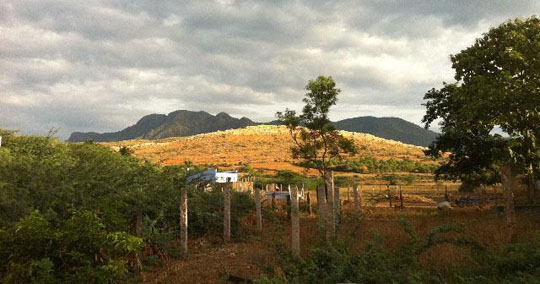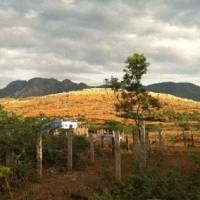G. Kallupatti is a small village in the Theni District of western Tamil Nadu, tucked up against the rocky foothills of the Western Ghats in southern India.
Unfortunately, the village is in a rain shadow on the eastern edge of these mountains, so precipitation is rare and much of the year G. Kallupatti is hot, dry and dusty.
Here and there along the town's narrow lanes and alleys you can find small, well-worn images of Ganesh, Shiva and Vishnu that attract supplicants of all ages throughout the day, some perhaps praying for rain or good crops. However, none of the carvings are big enough, old enough or sufficiently famous to draw tourists. Even India's ubiquitous foreign backpackers, who can be found in just about every nook and cranny of the country, are nowhere in sight.
Nevertheless, G. Kallupatti receives a steady stream of foreigners throughout the year coming to visit Reaching the Unreached (RTU), a secular service organization that since 1974 has been assisting the community's women and children, old, sick and homeless.
Earlier this month, six students and I visited India and Vietnam as part of an International Diplomacy course I co-teach in the Chuo University Law Faculty. Our study tour gave students a chance to see how governments, international organizations and nongovernment organizations interact in the international development community.
We began in Hanoi in late August, and spent four days meeting with employees of the Japan International Cooperation Agency (JICA), government officials and university students and professors. Then we traveled to Chennai and western Tamil Nadu for the rest of the tour.
Most people might expect these two rapidly developing nations to share some outward similarities, but other than chaotic urban traffic the differences between them are quite dramatic.
In fact, on closer inspection, driving styles differ considerably, too, with the Vietnamese handling traffic congestion far more quietly and efficiently. In contrast, traffic safety in India begins and ends with horn honking. Even the rear ends of trucks and buses are emblazoned with hand-painted phrases urging drivers, "Please Use Your Horn!"
None of my students had been to India or Vietnam before, and most had never been to a developing nation, so they each had their own epiphanies regarding class and caste, cultural expectations, stereotypes, and just how hot very hot curry can be.
For me, moving from Vietnam, where abundant water is as much a burden as a blessing, to southern India, which faces water scarcity similar to parts of the Middle East, the southwest of the United States and the plains of central Asia, water was on my mind much of the trip.
There is little doubt that water will one day soon be the new oil, a commodity so valuable that people and nations will go to war over access rights. But living in Japan, where water is rarely in short supply, and where typhoon rains and flooding are far more common than desiccated riverbeds, a visit to the arid expanses of Tamil Nadu is eye opening.
In and around much of G. Kallupatti and nearby villages we found expanses of parched fields and dry water courses. Local shortages have eased thanks to RTU, which has installed more than 2,000 bore wells and hand pumps and has seen to the building of catchment dams along some of the area's rivers.
But water quality varies, with shallower wells sometimes salty and nonpotable, though fine for washing and gardens. In contrast, the deepest wells provide water from hundreds of meters below the surface that is safe for even the most delicate foreign stomachs.
One sign on a tap at RTU says, "Pure, sweet, safe water," and as you can imagine, to be able to drink fresh water straight from the tap in parched Tamil Nadu is sweet indeed.
With water in such demand, you might assume that conservation would be second nature, but electricity is subsidized or free in some areas of India so farmers run pumps at little or no cost. As a result, India estimates that 60 percent of its farmers are using low-cost pumps even though the government has invested heavily in surface irrigation systems.
This increasing private irrigation is depleting groundwater resources, a threat to water sustainability, according to "Revitalizing Asia's Irrigation: To sustainably meet tomorrow's food needs," a 2009 report by the United Nations Food and Agriculture Organization (FAO) and the International Water Management Institute (IWMI). Furthermore, without improvements in irrigation efficiency, much of the water being brought to the surface evaporates or soaks into the ground before making it to crops.
With population continuing to rise across Asia, and water availability limited or dropping throughout the region, it will be essential for nations to raise agricultural productivity to feed millions more mouths using less water to grow more.
"Feeding the extra 1.5 billion people who will live on the (Asian) continent by 2050 will require more food than the region currently produces. Experts estimate that demand for food and animal feed-crops will double during the next 50 years," write the report's authors.
And if we do not find ways to do this, those who suffer most will be those who already have the least.
"When resources — water, arable land, other natural assets — become scarcer, we know that those without power will lose out and become even more vulnerable. Their ability to adapt needs to be strengthened and supplemented," noted Gunilla Carlsson, the Swedish minister for international development cooperation, in a speech at World Water Week in August 2009.
RTU is doing an admirable job of aiding the powerless and the very poor — a job the Indian government appears to have chosen to overlook. But overpumping groundwater is not sustainable in the long term.
Other concerns come to mind, as well. As the poorest become less so, their consumption increases. From an economic viewpoint this is arguably good because it bolsters Gross Domestic Product, which means our lives are getting better — or so economists tell us. But focusing solely on the immediate gains of overexploiting fresh water — or any other resources, including forests and marine ecosystems — only puts off the inevitable question.
That question is: When the world's population increases by 50 percent and reaches 9 billion, which the U.N. projects will happen in the next 50 to 75 years, will our planet's ecosystems be capable of feeding, clothing and housing us all, as well as assuaging our hunger for all the consumables that television programming is now beaming into every corner of the globe, even the tiniest villages?
There is no doubt that each one of us on the planet deserves a dignified life with sufficient water, food, clothing and housing, which means in the years to come nations will need to cooperate more peacefully and comprehensively than ever before. Simply providing everyone with enough water and food will be a monumental task. Refrigerators, air conditioners and cars for all are likely to be out of the question.
My students get this already. Now they're waiting to see how soon Asian and world policymakers can get it too.
Stephen Hesse is a professor in the Chuo University Law Faculty and is Director of the Chuo International Center. He can be contacted at: [email protected] All photos were taken in the Theni District of Tamil Nadu by Kaho Miyamoto, a second-year law student at Chuo University in Tokyo.







